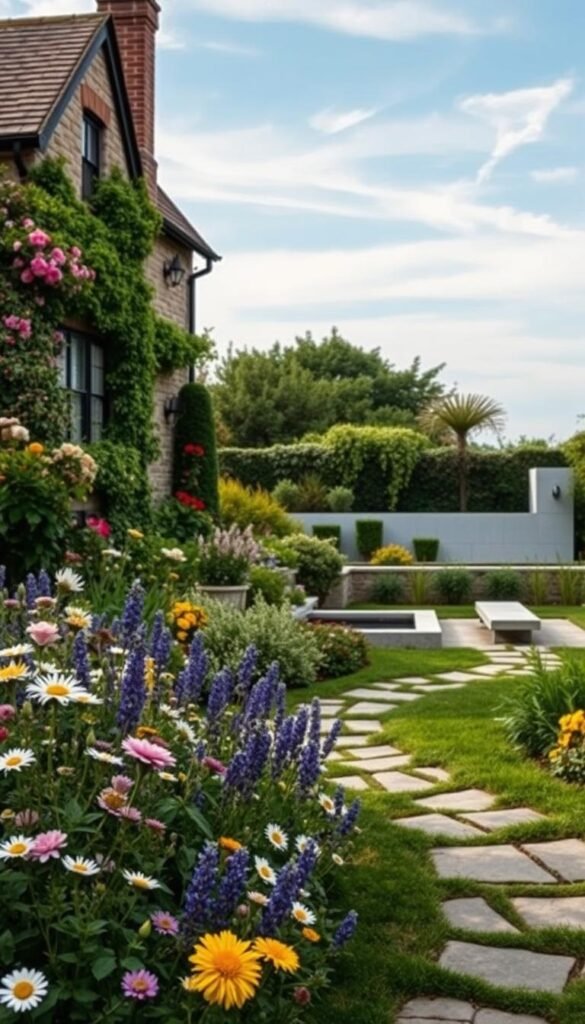Transforming your outdoor area starts with understanding foundational design approaches. While countless options exist, most landscaping concepts fall into four main categories: traditional, relaxed, contemporary, and natural layouts. This simplifies decision-making without limiting creativity.
You might feel overwhelmed when first exploring possibilities. Should you lean toward free-flowing plant arrangements or structured geometric patterns? The answer depends on how you want to use your space and what visual language speaks to you personally.
This guide focuses on two popular directions: one bursting with colorful blooms and another favoring clean lines. By comparing their core elements, you’ll identify what resonates with your lifestyle. Remember – your preferences matter more than strict design rules.
Many homeowners blend features from different aesthetics. A modern seating area could pair beautifully with wildflower borders. Your choices should reflect practical needs, whether you’re hosting friends or seeking quiet relaxation.
We’ll break down key characteristics to help you craft a space that feels authentically yours. You’ll gain confidence to mix textures, colors, and materials in ways that align with your vision for the property.
Understanding Garden Styles: A Blend of Tradition and Modern Flair
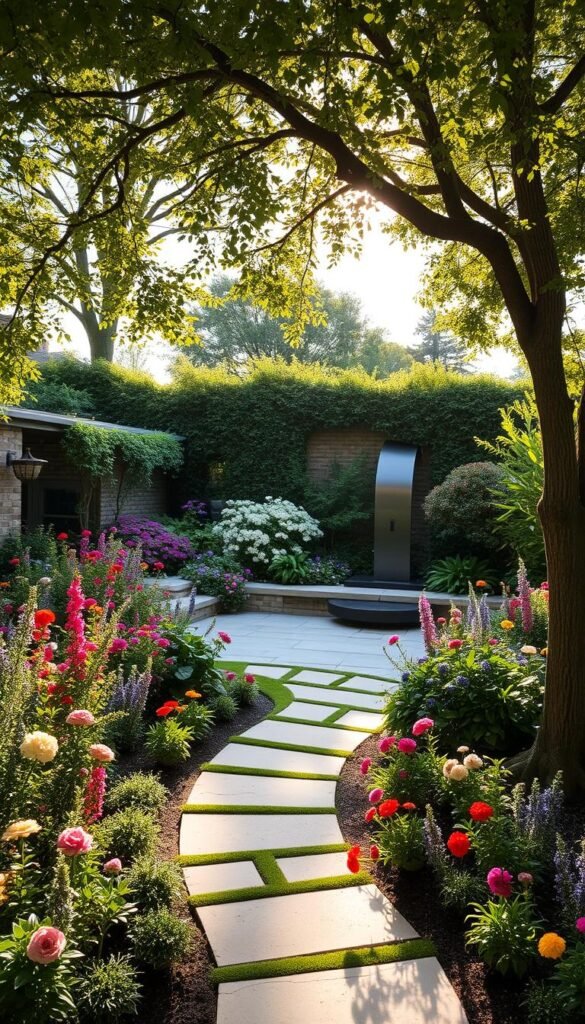
Creating an outdoor oasis begins with recognizing how historical patterns influence today’s spaces. Let’s explore two approaches that shape landscapes across America.
Exploring Traditional Elements and Symmetry
Classic layouts prioritize order through repeating shapes and balanced features. Picture boxwood hedges framing stone pathways or matching urns flanking a gravel courtyard. These design elements create visual harmony that complements colonial and European-inspired homes.
Key characteristics include:
- Geometric beds with uniform plant spacing
- Stone fountains as focal points
- Precisely trimmed shrubs forming living architecture
The Emergence of Contemporary Trends
Newer approaches maintain clean lines while embracing flexibility. Instead of formal symmetry, you might find angular concrete planters beside free-form ornamental grasses. Modern spaces often blend seating areas with drought-tolerant greenery for practical beauty.
| Feature | Traditional Approach | Contemporary Style |
|---|---|---|
| Layout | Mirror-image symmetry | Asymmetrical balance |
| Materials | Natural stone, wrought iron | Concrete, corten steel |
| Planting Style | Uniform hedges, topiaries | Mixed textures, grasses |
| Color Scheme | Green dominance | Bold contrasts |
Whether you prefer timeless elegance or urban sophistication, understanding these foundations helps you craft spaces that feel intentional. Remember – great gardens often borrow ideas from multiple eras while expressing personal taste.
Defining the Cottage Garden Aesthetic
Imagine stepping into a space where vibrant blooms mingle with fragrant herbs, creating a tapestry of color and texture. This living canvas balances wild beauty with subtle structure, inviting you to linger among its surprises.
Nature’s Paintbox Comes Alive
These spaces celebrate bold combinations where roses climb over sage and daisies nod beside thyme. You’ll find cut flowers like peonies sharing soil with basil, proving beauty and function coexist. Warm pinks, purples, and yellows dominate, while silver-green foliage prevents visual overload.
Structured Freedom in Design
Curved gravel paths might frame overflowing beds, creating secret nooks. Vertical elements like iron arches draped in clematis add height without rigidity. Upcycled ladders become plant stands, showing how creativity trumps perfection.
| Element | Common Choices | Practical Benefits |
|---|---|---|
| Floral Selection | Lavender, foxgloves, hollyhocks | Attract pollinators |
| Structural Features | Arbors, weathered benches | Create microclimates |
| Edible Additions | Rosemary, chives, calendula | Kitchen-ready harvests |
Dense planting deters weeds while creating habitats for beneficial insects. By layering plants from low-growing thyme to towering sunflowers, you maximize space and visual impact. Letting some varieties self-seed ensures delightful surprises each season.
Modern Designs Explained: Clean Lines to Contemporary Life
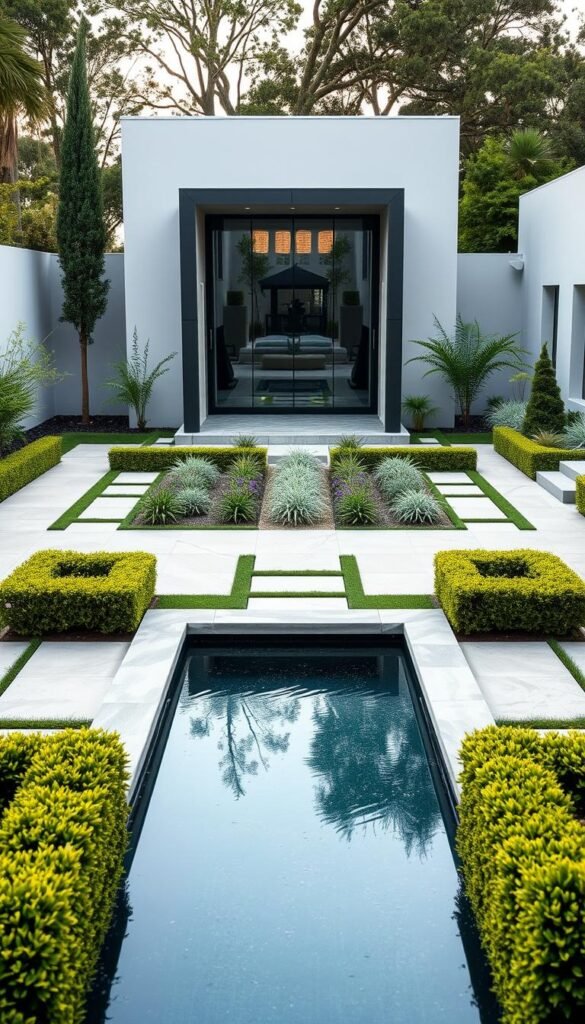
Outdoor areas become sleek extensions of your home through intentional design choices. Today’s approaches blend artistic vision with practical living, using geometry and restrained plantings to shape memorable spaces.
Sleek Materials and Geometric Sculptures
Modern layouts favor angular shapes over flowing curves. Picture rectangular concrete planters holding sculptural agaves or corten steel screens casting shadow patterns. These structures create visual rhythm without clutter, letting materials like polished stone take center stage.
Key differences emerge when comparing styles:
| Feature | Modern Style | Contemporary Approach |
|---|---|---|
| Shapes | Sharp angles | Curved accents |
| Materials | Concrete, metal | Wood, textured stone |
| Color Palette | Monochrome | Earthy tones + pops |
| Focal Points | Reflection pools | Fire pits |
Creating Inviting Outdoor Living Spaces
Your patio can function like an additional room. Built-in seating with weather-resistant cushions turns empty corners into conversation zones. Add warmth with strategic lighting – recessed deck fixtures or minimalist pendant lamps.
Choose plants for their architectural qualities. Japanese maples offer year-round foliage interest, while ornamental grasses sway gently in breezes. Keep arrangements sparse but impactful, letting each specimen shine against clean lines.
Water features become living art in these spaces. A narrow channel running beside stepping stones adds movement, while spherical fountains echo the design‘s geometric language. Every element serves a purpose, balancing form with function.
Cottage Flower Garden vs. Modern Designs: Finding Your Perfect Style
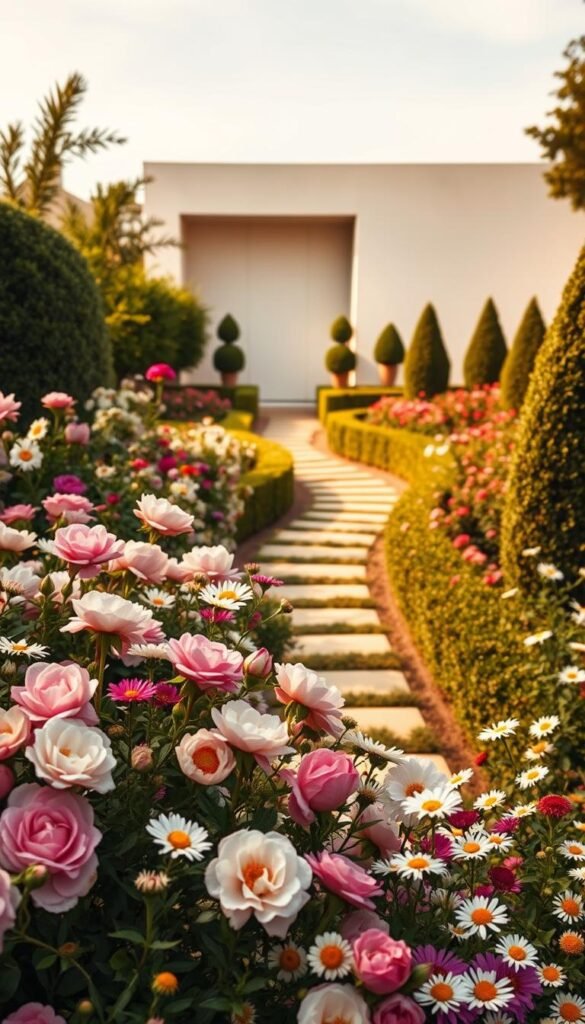
Your outdoor area should feel like a natural extension of your lifestyle. Before choosing between lush blooms or minimalist layouts, consider how you’ll interact with the space daily. Do you crave fresh herbs for kitchen experiments or seek a serene retreat after work hours?
Evaluating Practical Needs First
Start by measuring your available area and noting sunlight patterns. Urban balconies might thrive with vertical planting systems, while sprawling yards could accommodate mixed garden zones. Ask yourself:
- Will this space host gatherings or provide private relaxation?
- How much weekly maintenance can I realistically manage?
- Do local climate conditions favor certain plants?
Blending Aesthetics Creatively
Many homeowners achieve striking results by merging structural elements with organic growth. Try pairing geometric raised beds with billowing lavender clusters. Landscape design professionals often recommend using 70/30 ratios when mixing styles – predominantly one approach with accents from another.
| Consideration | Relaxed Approach | Structured Style |
|---|---|---|
| Time Investment | 4-6 hrs/week | 1-2 hrs/week |
| Plant Variety | 25+ species | 5-8 varieties |
| Hardscape Ratio | 20% paths/fences | 40% built features |
Remember that gardening aesthetics evolve over time. Begin with container arrangements or a small perennial border, then expand as your confidence grows. Your perfect space might combine stone walkways from modern designs with the playful textures of a cottage garden.
Planning and Planting Your Dream Garden
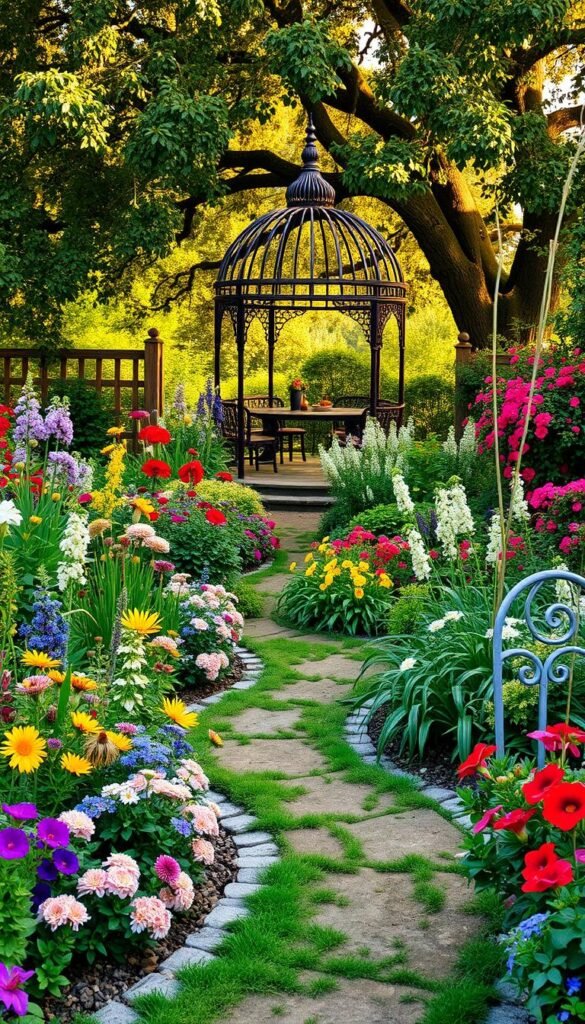
Crafting your ideal outdoor space begins with thoughtful preparation. Start by mapping curved pathways that guide movement through your layout. These natural flow lines become the skeleton for your living masterpiece.
Sketching Your Garden Layout with Intention
Begin with paper and pencil to visualize your vision. Draw walkways first, then assign zones for seating areas or plant groupings. This method ensures functionality before introducing botanical elements.
Follow the “smallest to tallest” rule when placing greenery. Position low-growing herbs like thyme near path edges. Mid-height shrubs and flowering perennials fill middle zones. Tall sunflowers or ornamental grasses anchor the back rows.
| Plant Height | Examples | Spacing Tips |
|---|---|---|
| Under 12″ | Thyme, Alyssum | 6-8″ apart |
| 12-36″ | Coneflowers, Sage | 18-24″ between |
| Over 36″ | Hollyhocks, Grasses | 30-36″ clearance |
Choosing the Right Plants and Design Features
Mix reliable perennials with seasonal annuals for year-round appeal. Peonies and lavender form the backbone of your garden, while zinnias add pops of summer color. Always check mature sizes to prevent overcrowding.
Smart spacing lets each plant thrive while creating lush visuals. Allow room for growth – that tiny sage seedling will triple in size by next year. Divide established perennials every 3-4 seasons to refresh beds and share extras with neighbors.
Remember: Your soil type and sunlight patterns dictate success. Test ground pH before planting acid-loving shrubs like hydrangeas. Match species to your climate zone for low-maintenance beauty that deepens with time.
Care, Maintenance, and Upkeep for Long-Lasting Beauty
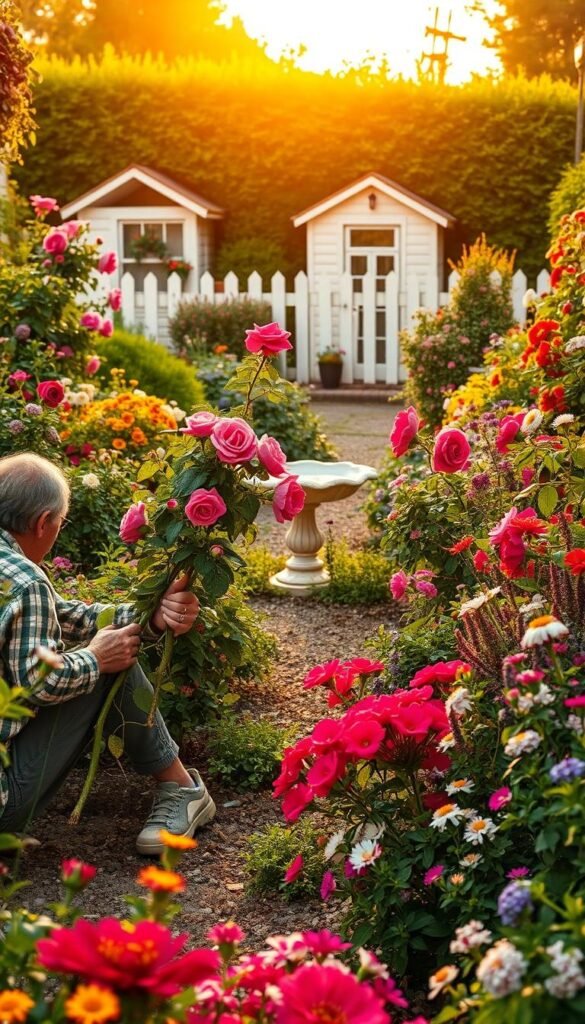
Keeping your outdoor space thriving requires smart care strategies tailored to your chosen style. Both lush floral displays and minimalist layouts need seasonal attention to maintain their charm. Let’s explore routines that protect your investment while letting nature shine through.
Seasonal Care Tips for Both Styles
Spring starts with clearing debris and refreshing mulch. For dense plantings, divide crowded perennials every 3-4 years. This prevents root competition and gives you free plants for new beds. Summer demands weekly deadheading – snip spent blooms just above leaf nodes to encourage reblooming.
Combat pests naturally by planting marigolds near vegetables or spraying neem oil mixtures. A simple solution: 1 tablespoon neem oil + ½ teaspoon dish soap in a quart of water. Apply at dawn to avoid harming beneficial insects.
| Season | Key Tasks | Tools Needed |
|---|---|---|
| Spring | Soil amendment, dividing perennials | Spade, compost |
| Summer | Deadheading, pest monitoring | Pruners, spray bottle |
| Fall | Mulching, bulb planting | Rake, organic mulch |
| Winter | Protecting tender shrubs | Burlap, twine |
Manage weeds efficiently by pulling them after rain when roots slip out easily. Apply 2-3 inches of wood chip mulch to block sunlight and reduce germination. This tactic works equally well around structured modern grass plantings and cottage-style borders.
Winter prep varies by climate. In snowy regions, wrap delicate shrubs in burlap. Southern gardeners should cut back ornamental grass clumps to 6 inches before new growth emerges. Consistent care ensures your space grows more beautiful each year.
Final Thoughts for Inspired Garden Living
Your outdoor space becomes a personal retreat when you let creativity shape its character. Forget rigid formulas – successful gardens thrive on choices that reflect your daily joys. Mix edible greens with fragrant blooms, or tuck medicinal herbs between ornamental grasses. Every plant earns its spot by serving multiple roles, from snack-ready veggies to pollinator magnets.
Rustic fences or weathered trellises add depth while supporting climbing roses or beans. These elements create living walls that change with the season, offering fresh visual interest monthly. Why choose between beauty and function when plants like lavender offer both aromatic foliage and cut flowers?
Remember, blending structure with wild beauty often yields the most inviting gardens. A neat herb spiral might anchor a riot of zinnias, proving organized plantings coexist with free-spirited growth. For more ideas on balancing these approaches, explore our guide to personalizing your outdoor space.
Start small if you’re new to gardening. A sunny corner with basil, marigolds, and cherry tomatoes demonstrates how variety enhances both aesthetics and ecology. As confidence grows, expand your palette – perhaps adding a dwarf fruit tree or moonlit pathway. Your home’s exterior should feel as uniquely yours as its interior.

